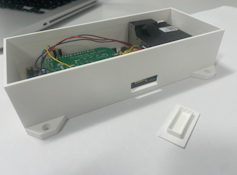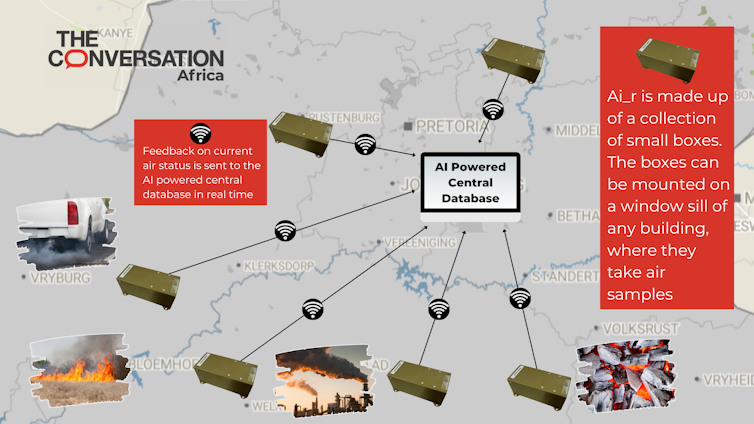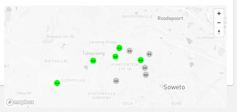Air pollution in South Africa: affordable new devices use AI to monitor hotspots in real time


Air Quality Monitoring in Africa: A Step Towards Achieving the Sustainable Development Goals
Air quality has become one of the most important public health issues in Africa. Poor air quality kills more people globally every year than HIV, TB and malaria combined. And that’s just the tip of the iceberg. Air pollution makes people less productive because they get headaches and feel tired.
India, for example, has poor air quality. The impact of India’s poor air quality on its gross domestic product is about US$100 billion every year.
The Need for Cost-Effective Air Quality Monitoring
The health risks of poor air quality are known. But it’s always been costly to set up monitoring stations to measure it regularly.
I am a particle physicist, and the director of the Institute for Collider Particle Physics at the University of the Witwatersrand and the iThemba Laboratories for Accelerator Based Sciences, a unit of South Africa’s National Research Foundation. As part of our technology transfer activities, we launched the South African Consortium of Air Quality Monitoring, a multidisciplinary team of scientists with strong connections with policy makers and who are interested in improving air quality in South Africa.

Courtesy SACAQM
The Ai_r System: Revolutionizing Air Quality Monitoring
We decided to create, for the first time in South Africa, a cost-effective air quality monitoring system based on sensors, Internet of Things, and Artificial Intelligence. We have named this system Ai_r.
Our team of 25 people includes more than 20 years of experience as particle physicists in working with sensors, communications, and artificial intelligence. In particle physics, we create complex systems with different technologies and different disciplines. Particle physics includes electrical and information engineering, data science, and artificial intelligence, among others.
There are only 130 big air quality measuring stations in South Africa. They only measure the air quality in the vicinity of the station. This is why we need cost-effective, dense networks made up of Ai_r systems set up all around these stations, to measure air quality in a much wider area.
Our vision is to place tens of thousands of these devices all over South Africa.
Using Artificial Intelligence for Accurate Monitoring and Forecasting
Ai_r is made up of a collection of small boxes that cost about US$100 to make. The boxes can be mounted on a window sill of any building, where they take air samples and feed this data back to a cloud in real time. Modelling and forecasts are made with artificial intelligence coupled to the cloud.
Artificial intelligence does not do magic. It is a bunch of mathematical tools that scientists control to perform a task. It integrates sets of data, learns from the data, and creates automatic models. That saves a tremendous amount of resources.
In air quality monitoring, artificial intelligence will learn from the vast wealth of data that these sensors will produce and then make predictions. For example, Ai_r will be able to tell us the impact of weather changes on air quality so that we know which areas will have more polluted air.
Without artificial intelligence, it would be very difficult to come up with a cost-effective system that could monitor air quality and give us predictions.

Bruce Mellado
Measuring Air Quality in Johannesburg
When measuring air quality, the goal is to identify the hotspots (where air quality is worst), not just the average air quality in the city.
A hotspot of very polluted air can be situated quite close to a cold spot where the air quality is better. For public health reasons, we need to know and be able to forecast where the air quality will be bad on any given day. This is the only way we will be able to convince the authorities to set up ways to curb air pollution in badly affected areas.
We have already rolled out about 20 of the new devices in Soweto and Braamfontein in Johannesburg, and 120 more are coming in the next months. Both parts of the city have tens of thousands of vehicles driving through every day, putting them at high risk of air pollution.
Read more:
Africa has an air pollution problem but lacks the data to tackle it
We have also placed air quality sensors at the University of the Witwatersrand and iThemba LABS. We have an agreement with the Gauteng Department of Education to deploy these at schools in the Soweto area. Hospitals in the private Netcare group have also agreed to host the air quality devices.
There is a public dashboard on our website where you can see all the data we gather.

Courtesy SACQM
The project was launched in June 2024. The government has reacted very positively to this and we are now integrating the system into the official South African system of air quality scores, SAAQIS. We also encounter strong support by the City of Johannesburg to deploy further.
The Ai_r system measures particulate matter 2.5. These are extremely tiny particles of polluting matter such as dust, dirt, soot, or smoke. The problem with these particulates is that people inhale them. They get into people’s bloodstreams and can cause heart attacks, cancer, and other diseases. This is why the amount of particulate matter 2.5 is typically used as a benchmark for air quality globally.
How Ai_r Works
The air quality device is housed in a box. It has a small laser that shoots light onto air. Depending on how that light scatters and reflects, you can measure the concentration of particulates. Then the measurements are sent to the tiny computer inside the box which communicates through an antenna every five minutes, through Internet of Things technologies, to a cloud-based system where the data is stored. So nobody has to be there collecting air quality samples anymore.
Read more:
Air pollution, temperature and respiratory disease: a South African study
We have also optimized the devices so that they use very little electricity. In cases of electricity power cuts, the devices have cost-effective batteries that last for days. They are very easy to maintain. They are affordable to roll out across South Africa.
The existing network will keep growing to become, towards the end of 2024, the largest cost-effective, automated air quality measurement system in Africa.
We really need to measure pollution and find out just how bad it is so that mitigating strategies can be designed that target problem areas very efficiently. The goal is to improve air quality for people who are most affected by air pollution.
(The author would like to thank South Africa’s Department of Science and Innovation, the National Research Foundation, the Canadian International Development Research Centre, and the Clean Air Fund for their support.)
SDGs, Targets, and Indicators
-
SDG 3: Good Health and Well-being
- Target 3.9: By 2030, substantially reduce the number of deaths and illnesses from hazardous chemicals and air, water, and soil pollution and contamination.
- Indicator 3.9.1: Mortality rate attributed to household and ambient air pollution.
-
SDG 8: Decent Work and Economic Growth
- Target 8.8: Protect labor rights and promote safe and secure working environments for all workers, including migrant workers, in particular women migrants, and those in precarious employment.
- Indicator 8.8.2: Frequency rates of fatal and non-fatal occupational injuries, by sex and migrant status.
-
SDG 11: Sustainable Cities and Communities
- Target 11.6: By 2030, reduce the adverse per capita environmental impact of cities, including by paying special attention to air quality and municipal and other waste management.
- Indicator 11.6.2: Annual mean levels of fine particulate matter (e.g. PM2.5 and PM10) in cities (population weighted).
-
SDG 13: Climate Action
- Target 13.2: Integrate climate change measures into national policies, strategies, and planning.
- Indicator 13.2.1: Number of countries that have communicated the strengthening of institutional, systemic, and individual capacity-building to implement adaptation, mitigation, and technology transfer, and development actions.
Table: SDGs, Targets, and Indicators
| SDGs | Targets | Indicators |
|---|---|---|
| SDG 3: Good Health and Well-being | Target 3.9: By 2030, substantially reduce the number of deaths and illnesses from hazardous chemicals and air, water, and soil pollution and contamination. | Indicator 3.9.1: Mortality rate attributed to household and ambient air pollution. |
| SDG 8: Decent Work and Economic Growth | Target 8.8: Protect labor rights and promote safe and secure working environments for all workers, including migrant workers, in particular women migrants, and those in precarious employment. | Indicator 8.8.2: Frequency rates of fatal and non-fatal occupational injuries, by sex and migrant status. |
| SDG 11: Sustainable Cities and Communities | Target 11.6: By 2030, reduce the adverse per capita environmental impact of cities, including by paying special attention to air quality and municipal and other waste management. | Indicator 11.6.2: Annual mean levels of fine particulate matter (e.g. PM2.5 and PM10) in cities (population weighted). |
| SDG 13: Climate Action | Target 13.2: Integrate climate change measures into national policies, strategies, and planning. | Indicator 13.2.1: Number of countries that have communicated the strengthening of institutional, systemic, and individual capacity-building to implement adaptation, mitigation, and technology transfer, and development actions. |
Analysis
-
SDG 3: Good Health and Well-being
The article highlights the health risks associated with poor air quality, including increased mortality rates. This aligns with SDG 3, which aims to ensure good health and well-being for all. Specifically, Target 3.9 focuses on reducing deaths and illnesses from air pollution and hazardous chemicals. The indicator mentioned in the article, Indicator 3.9.1, measures the mortality rate attributed to household and ambient air pollution.
-
SDG 8: Decent Work and Economic Growth
The article mentions the economic impact of poor air quality on India’s gross domestic product. This relates to SDG 8, which aims to promote decent work and economic growth. Target 8.8 focuses on ensuring safe and secure working environments, including protection from environmental hazards. The indicator mentioned in the article, Indicator 8.8.2, measures the frequency rates of fatal and non-fatal occupational injuries.
-
SDG 11: Sustainable Cities and Communities
The article emphasizes the importance of monitoring air quality in cities and reducing the adverse environmental impact. This aligns with SDG 11, which aims to create sustainable cities and communities. Target 11.6 specifically addresses air quality and waste management. The indicator mentioned in the article, Indicator 11.6.2, measures the annual mean levels of fine particulate matter in cities.
-
SDG 13: Climate Action
The article discusses the integration of climate change measures into national policies and planning to address air pollution. This relates to SDG 13, which focuses on taking urgent action to combat climate change and its impacts. Target 13.2 specifically addresses the integration of climate change measures into policies and planning. The indicator mentioned in the article, Indicator 13.2.1, measures the number of countries that have communicated capacity-building efforts for climate action.
Source: theconversation.com








